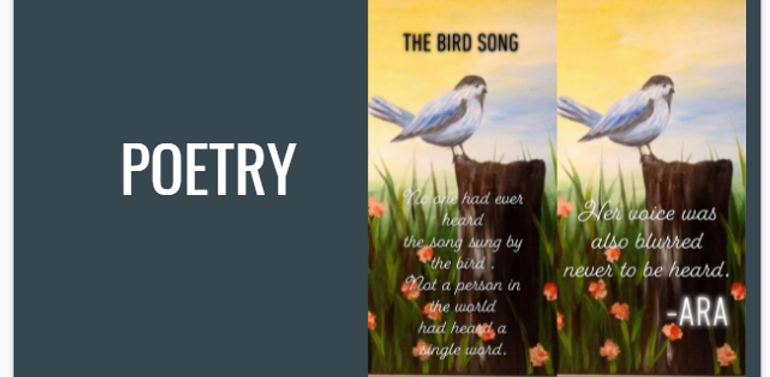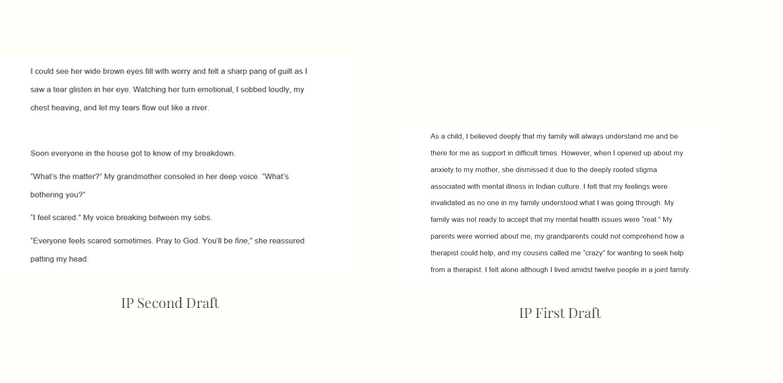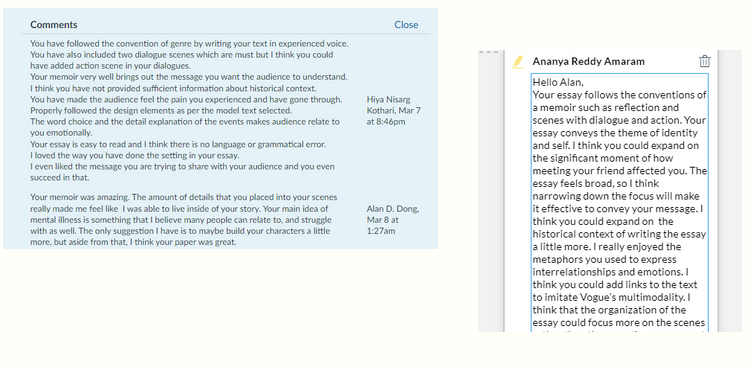Multimedia Showcase

Multimodal
Writing
Multimodal Writing involves using various kinds of multimedia such as as images, audio, video, animations and interactive content along with text. Using different kinds of media illustrates the message clearly and engages the audience. Learning how to employ the affordances of multiple modes (linguistic, visual, aural, spatial, and gestural) to support metacognitive arguments and analysis is one of the course objectives of Writing 37.
As we branch off into writing the Imitation Project Multimodal Memoir , we are supposed to learn how to go beyond alphabetic writing and write a memoir using different multimedia. The following artifacts are curations of my learning moments in multimodal communication.
Artifact 1
Presenting Personality

An excerpt from my 'Me in Six Words' Presentation as an example of multimodal communication
In the first week of Writing 37, we were required to make a “Me in Six Words” presentation to introduce ourselves through six words and six pictures. Through this assignment I learned how to communicate through multimedia by using text and images collaboratively. It helped widen my perspective towards writing as it made me understand that there are multiple modes of communicating the same message. Moreover, the assignment allowed me to express my Creativity which according to the Habits of Mind is the ability to use novel approaches for generating, investigating, and representing ideas. It also helped me develop Openness – the willingness to consider new ways of being and thinking in the world. Writing across media helped me become an expert in the conversation about home, family, and self (identity, language, ethnicity) and relate to the course theme by making me understand how visual writing using images can help us express ourselves through an illustration. Composing multimedia to introduce myself helped me learn how a “picture can speak a thousand words” and how using text as well as image is a more effective way of communicating than using plain text. I learned how to format the visual elements such as font size, text color and image to have a standard theme in my presentation. The limitation of only one word to express one thing about me made me think of specific words and use specific images to try to concisely express my identity as best as I can in six words and pictures.
Here is a link to my 'Me in Six Words' Presentation.
Artifact 2
Watching and Writing
The Ted talk by Chimamanda Adichie from the Watch and Quick Write Assignment as an example of multimodal communication.
As a part of the Watch and Quick Write assignment, we were supposed to watch a video in the form of a Ted Talk by the Novelist Chimamanda Adichie and then write a response to the prompt - 'As individuals, we have many different stories. Write about an experience where you've been given a single story due to your cultural, social, political, vocational, or relational identity.' This assignment helped me understand how to analyze the affordances of different modes (linguistic, visual, aural, spatial, gestural) in appropriate genre models according to the course objectives. Watching the video made me improve my auditory comprehension as it required me to analyze the message which was mainly in the form of an audio as it was a speech. Reading across media, particularly audiovisual, helped me understand how the use of different media convey the rhetor’s emotions and feelings. The audience are thus able to relate to the rhetor and the message as they connect to the author’s character. I also learned how to quote lines from the video as evidence in my writing. Researching about multimedia helped me amplify my knowledge of the conversation about the rhetoric of home, family, and self(identity, language, ethnicity) and ways of storytelling because the video’s message focused on the Chimamanda Adichie’s views on how labelling people through a single story does not define their identity.
Here is a link to the Ted Talk by Chimamanda Adichie.
Artifact 3
Developing Dialogues

Side by Side comparison of my IP Multimodal Memoir Second Draft Demonstrating the Development of Dialogues and First Draft with Narrative Summary.
Dialogues are integral in storytelling as they add action and depth to a story. Revealing the characters in my memoir through dialogues helped me make the story relatable and engaging. Developing my dialogues required me to recall my memories of the moment and interview family members who are characters in my memoir. I learned how to add gestures to dialogues to add action for the characters in the scene. Writing dialogues also helped me reduce the narrative summary for introducing the characters to the readers. I have used dialogues to introduce my grandmother in my second draft as opposed to my first draft where I had written a brief description of my grandmother’s response to the moment. The employment of dialogues in the second draft of the IP Multimodal Memoir showcases the key skill of learning to present scenes action and dialogue with a sparing use of narrative summary according to the IP rubric.
I learned that I could not recall the dialogues completely from a past memory and that I required additional resources such as consulting family members to help me write my dialogues. This also allowed me to reflect on the moment from the perspective of the characters and therefore helped me in character and plot development. Writing dialogues is important to understanding how to use rhetoric because dialogues have the ability to portray the scenes in the plot and help the readers visualize. Dialogues make the story more realistic and add credibility to the writer, and thus are important to becoming a member of the academic discourse community. They demonstrate that the writer can follow the conventions of a specific genre. Mastering the skill of writing dialogues elevates the academic ethos of the writer as effective dialogues have the power to evoke emotions and influence the readers. Developing dialogues for a scene can also be applied to other writing assignments beyond college as dialogues are an essential part of communication.
Artifact 4
Scripting Scenes

Side by Side comparison of the scenes from my IP Multimodal Memoir Second and First Draft.
Scripting scenes involves describing the setting, mood, characters, action, and dialogues. I learned how to integrate the essential elements of a scene by including the transitional description of the setting of my scene before my dialogues in the second draft of the IP memoir as opposed to abruptly breaking into dialogue as in the first draft. It demonstrates that the story is crafted using literary techniques and devices to write scenes as a cohesive element of my writing according to the genre and medium requirements of the IP rubric. Writing scenes that fit smoothly into the text provided an insight on how to narrate a story that engages readers by incorporating a variety of elements to form a homogenous narrative where all the pieces of writing such as dialogues, descriptions and actions complement each other. Scenes are important to understanding rhetoric as the writer has to make choices regarding the setting up of a moment as per the conventions of writing a memoir. The mastery of this skill is required to my academic ethos because it shows that I can write a memoir which hooks the readers in and provides all the essential information to the audience without raising questions while reading or confusing them. I have understood how scenes can be used as tools to convey the information that the audience would be unaware of and answer any questions that would arise in their minds while reading. Scripting scenes can be useful beyond the classroom in learning how to integrate the various elements of writing into a work that is well wounded.
Artifact 5
Analyzing Audience

A snapshot of a slide from my IP Multimodal Memoir Pitch Presentation
The IP Memoir Pitch Presentation required thorough research and analysis of the audience of the model text used for imitation. Reading the various memoirs published on the model text that I have chosen provided insight on the expectations, thoughts, values, and beliefs of the audience I was targeting. This helped me align the message I wanted to convey through the memoir with the medium and audience by understanding what topics are addressed by the publication. Learning to analyze audience allowed me to apply the rhetorical triangle of communication to writing the memoir. For the pitch, I had to present a theme, message, and significant moment which the memoir will focus on with respect to the target audience of Teen Vogue, the model publication I chose for the project. I learned how to analyze the demographics and psychographics of a publication to curate my article in alignment with the style of the chosen publication. This demonstrates that the place of publication is well-chosen and actually publishes memoir/personal narrative essays and that I have made rhetorical choices in order to relate to the target audience according to the IP rubric. Analyzing audience is important to rhetoric because it helps the writer employ strategies to communicate the message effectively to the audience by understanding what interests and engages them. This learning has helped me evolve into an academic writer as it demonstrates that I can make impactful rhetorical choices while writing and use the conventions of a medium to appeal to the audience. Analysis and research is a skill which is essential in future courses and beyond college as it helps in gauging the expectations and interests of a targeted group of people for effective communication.
Here is a link to my IP Multimodal Memoir Pitch Presentation.
Artifact 6
Reviewing and Revising

Snapshot of the Peer Review I gave and received on the Second Draft of the IP Multimodal Memoir.
Peer Review of writings is a conventional feature of the academic discourse community. I have learned that giving peer review on the works of others is often beneficial to the person reviewing. Giving peer review on the memoirs of my classmates helped me objectively consider the employment of conventions of the memoir and the requirements in the IP rubric. Reading the memoirs of my peers helped me appreciate the conventions of memoirs such as the experienced voice, dialogues, scenes, and theme. Having to address each section of the rubric and the webpage made me review the requirements and objectives in order to reflect on my memoir in accordance with the rubric. I learned how to evaluate writings based on certain criteria and provide constructive feedback as per the conventions of academic writing. The suggestions offered during peer review reinforce appreciation and support among the members of the academic discourse community while offering advice for possible revisions. I provided revision advice about the message and organization of my peers' memoir. The comments that my peers have provided on my memoir in return have helped me identify areas that require work and understand how to overcome the drawbacks mentioned. I had received feedback on the development of the characters, organization, and context of my memoir which I incorporated as it provided me an insight into the minds of my target audience of which my peers are a part of too. Thus, I was able to understand the shortcomings of my memoir from the perspective of the readers and revise my essay to meet the interests of the readers, convey the message effectively and meet the objectives of the rubric. Peer review can be applied beyond the Writing 37 class in professional writings and workspaces where collaboration is required.
Conclusion
Learning how to communicate using multimedia expands our skills as communicators as it helps us develop well-rounded messages using textual, auditory, visual, and interactive media. It helps us learn how to interpret and analyze information from various media. The 'Me in Six Words' presentation helped me explore the concept of self as I thought of specific words and images to describe my identity although I had limitations on the number of words and pictures. Moreover, the response to the Ted talk helped me evaluate how a single story had affected my perceptions of identity and ethnicity. It has helped me gain solid knowledge on an abstract concept that I would have had difficulty developing without the experience of reading and writing across multimedia. I learned how to analyze the rhetorical situation and understand the audience through the kind of media. Multimodal information in the form of video, audio and image helped me engage with the message effectively and develop my understanding of self and identity which is a theme of the class. Such knowledge will help me develop my Imitation Project Multimodal Memoir because a Memoir is a subgenre of Non-fiction focused on exploring the self through writing. The experience across different media will help me write a memoir incorporating different kinds of media appropriately and effectively as I have now gained a better understanding of not only the use of different kinds of media and its effects on the audience but also the aspects of self and identity.
Reflection
The Multimodal Memoir essay shines light on an important social message about mental health to the audience of Teen Vogue. In reflecting on my experience with anxiety in my memoir, I am able to share my story to increase the awareness about mental health issues and advocate the importance of prioritizing mental health. It has been challenging to write about something so personal, yet, so important to me. I feel like my memoir has successfully portrayed my struggles but hasn’t focused sufficiently on how I developed as a person or how the significant moment impacted my views of self, identify and family. I could have worked more on integrating the experienced voice with reflection and insight throughout the memoir for a more well-rounded story. I think that I have been able to effectively analyze the audience, develop the dialogues, describe the scenes, and therefore follow the genre conventions such as setting, dialogues, action, scenes, and reflection. The memoir also aligns with the theme of the class which is the rhetoric of home, family, and self. I have learned how to introduce and develop my characters to provide the backstory to help the audience relate to the characters. However, I think I should have integrated the historical and cultural context at the time of writing the memoir into the text more effectively. Overall, the memoir meets the IP rubric in terms of genre, message, and targeting audience. The IP Multimodal Memoir is ,therefore, an application of my knowledge of genre and genre conventions.
